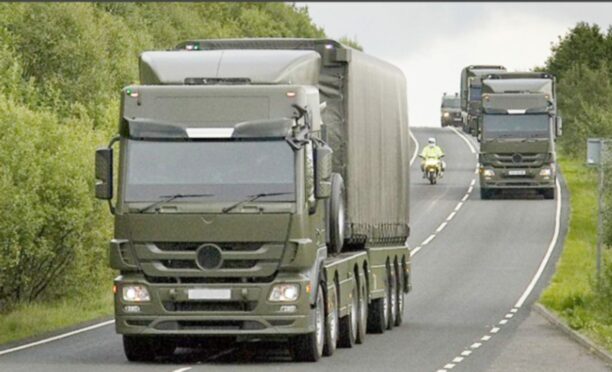
An exercise testing the emergency response to a nuclear bomb convoy crashing, exploding and spreading a cloud of radioactive contamination was plagued by errors and confusion, according to official reports.
The assessments of the drill by the Ministry of Defence (MoD) reveal it was blighted by “errors and confusion”; shortages of medical equipment; poor care for casualties and multiple mistakes in radiation monitoring. One set of radiation readings was wrong “by a factor of 1,000 times”.
The exercise, codenamed Senator 2018, took place over five days in October of that year at the MoD site at Longtown, in Cumbria. It included the emergency services, local and national government.
Campaigners initially made a Freedom of Information request for post-mortem reports on Senator 2018 in January 2019. It took the MoD four years to respond, releasing two redacted reports in January 2023.
According to the reports, the exercise envisaged a “catastrophic and improbable” accident on the M6 near Carlisle involving a nuclear weapons convoy on its way north to Faslane. The driver of a lorry travelling south was imagined to lose control and crash into a nuclear warhead carrier. This causes the “partial detonation” of a nuclear warhead’s conventional high explosive and a fire with multiple casualties and serious injuries. These result in “a plume of radioactive material” which is “carried on an easterly wind towards Carlisle”.
A convoy of 20 or more vehicles transports nuclear warheads between the Burghfield nuclear weapons factory, in Berkshire, and the Royal Navy’s armaments depot at Coulport on Loch Long, Argyll and Bute, at least six times a year.
The warheads require regular maintenance. The Ferret investigative news site revealed in January that the convoy had logged 40 safety incidents in the last three years, including two crashes, brake faults, breakdowns and power losses. We also reported in 2016 how mistakes in earlier nuclear bomb exercises could have led to “avoidable deaths”.
One of the reports is a 50-page post-mortem of Senator 2018 by its MoD director, who is not named. The other is a 42-page report from the MoD’s two watchdogs, the Defence Nuclear Safety Regulator and the Defence Nuclear Security Regulator. Both were marked “official sensitive”.
They concluded that “overall Senator was an adequate test of the emergency arrangements” but highlighted multiple issues that arose.
One was that nuclear convoy vehicles didn’t have enough bags of medical equipment. “Only two contained full medical bags,” said MoD regulators, suggesting this could be “due to a lack of appropriate funding”.
Convoy crews complained that they lacked training in how to assess the urgency of injuries. Shortages of masks to prevent the inhalation of radioactive particles “meant some of the casualties did not receive a mask”.
Injured people were left unattended. “This resulted in a poor handover of casualties with little detail on casualty condition or treatment being passed to the ambulance service,” said regulators.
Radiation monitoring errors included an air sampler that hadn’t been calibrated, wrong-sized filter papers and “confusion” over radiation units. Monitoring teams were said to be “clearly inexperienced”, protocols were not followed and some places left unmonitored.
The convoy fire crew ran out of water after 40 minutes because back-up supplies from the Cumbrian fire service were delayed by blocked roads. After the fire was put out, the Cumbrian service offered to help rescue casualties, but this was rejected by the convoy crew commander.
“Post-exercise comments suggest the offer should not have been declined,” reported MoD regulators.
Identifying, moving and disposing of bomb debris was delayed. Differing procedures used by bomb disposal units run by the army and the Atomic Weapons Establishment resulted in “confusions over whose process should be followed”, said the exercise director.
Commanders used “imprecise language”, according to MoD regulators. “Incorrect information was not always corrected quickly enough.”
Jane Tallents, of Nukewatch, which monitors nuclear convoys, said: “These rehearsals show just how complex and damaging a nuclear weapons emergency could be, and how poorly prepared the MoD is.”
The Scottish Campaign for Nuclear Disarmament’s Janet Fenton said: “When you add in the fact that this dangerous traffic is to maintain a horrific weapon of mass destruction, the carelessness and disregard for human welfare is beyond the pale.”
The SNP MP for West Dunbartonshire, Martin Docherty-Hughes, suggested that accidents like that in the exercise could not be ruled out. “The idea that a plume of radioactive material could be floating across Clydebank, Dumbarton or the Vale of Leven leaves me with a sense of dread,” he said.
The Ministry of Defence declined to answer questions on the status of the 47 enforcement actions resulting from Senator 2018 or the 10 from previous exercises. It also wouldn’t say what nuclear exercises have taken place since 2018.
It said: “Routine exercises such as Senator 2018 are conducted regularly to demonstrate our preparedness to respond to any incident, no matter how unlikely.”

Enjoy the convenience of having The Sunday Post delivered as a digital ePaper straight to your smartphone, tablet or computer.
Subscribe for only £5.49 a month and enjoy all the benefits of the printed paper as a digital replica.
Subscribe